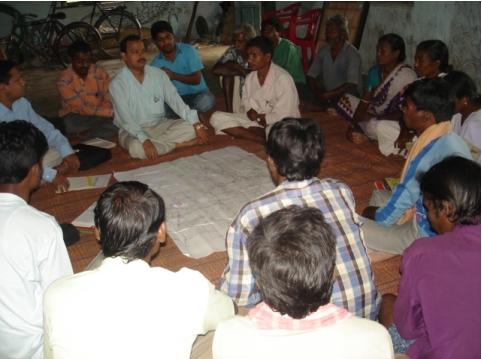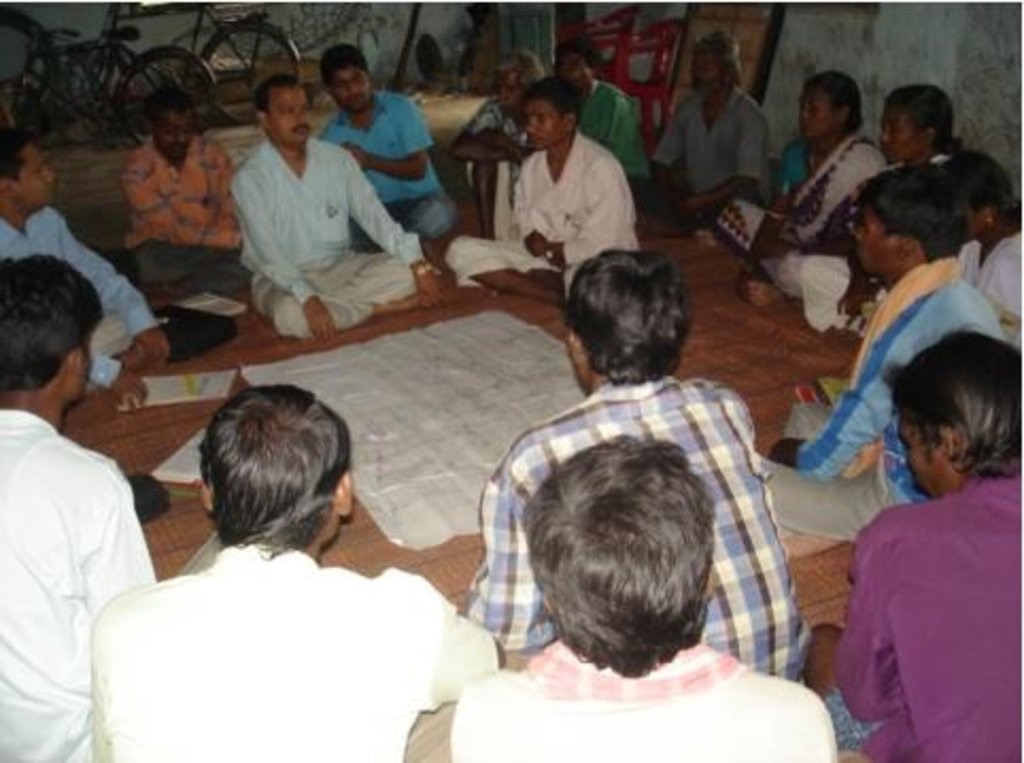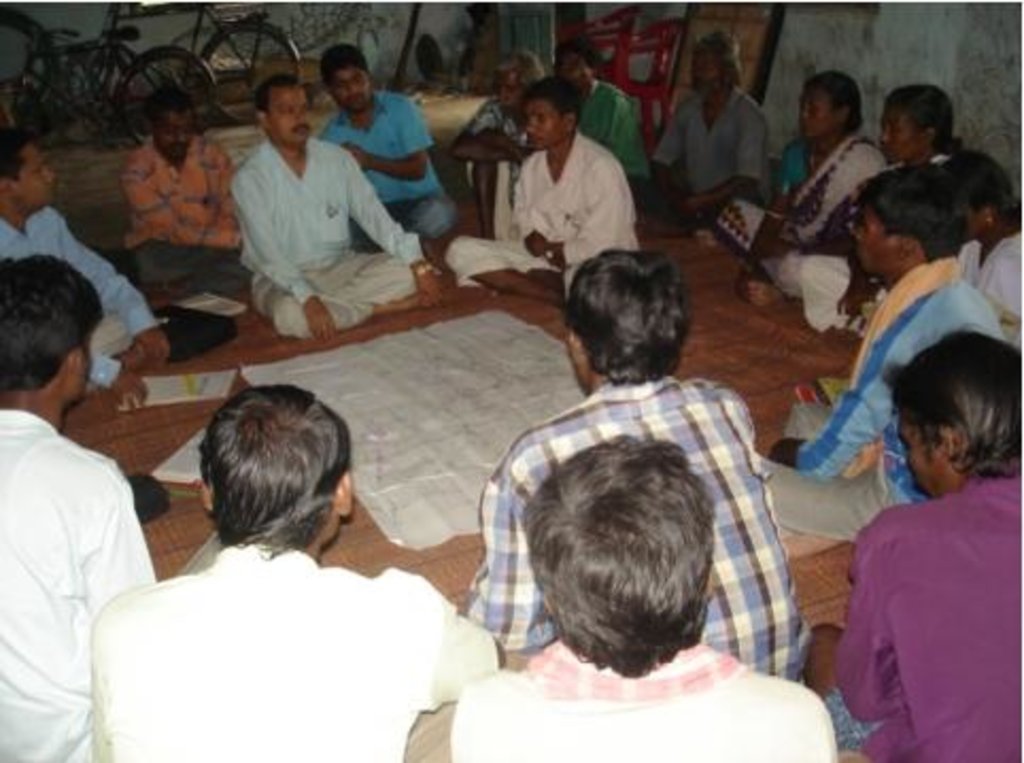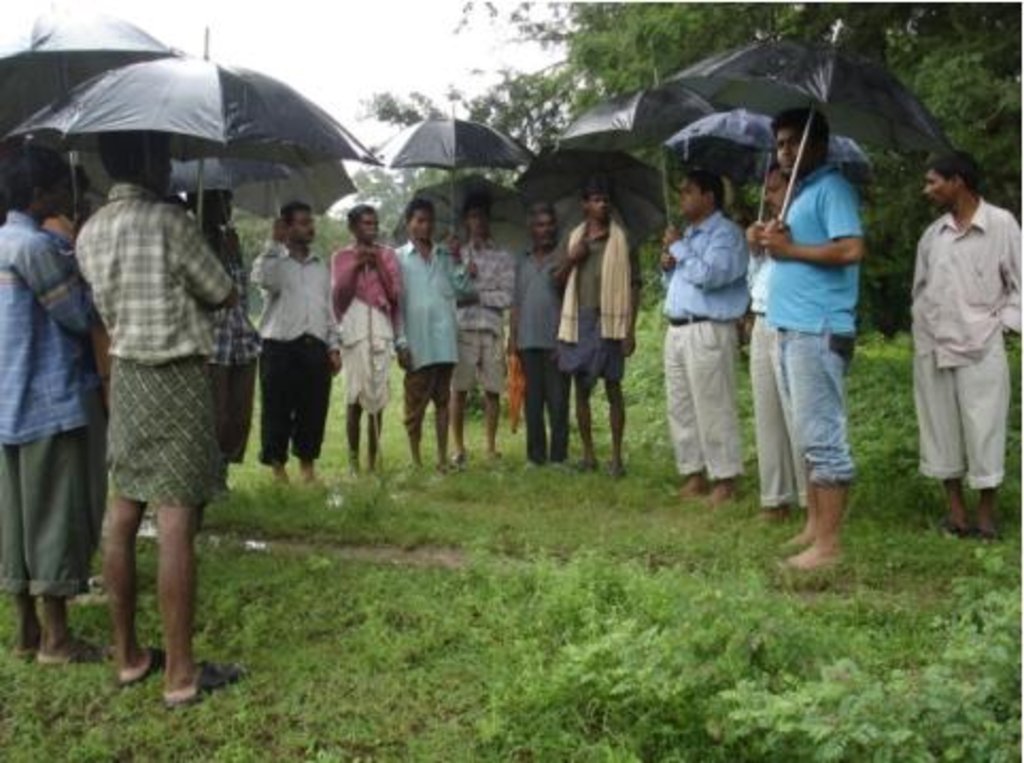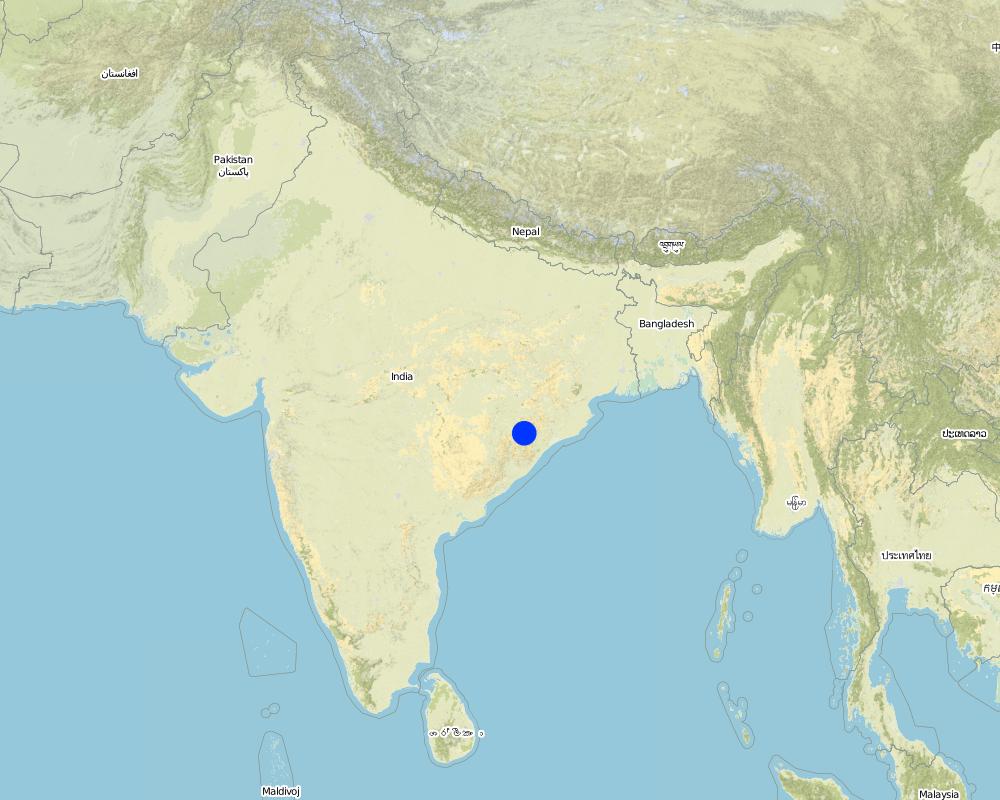Common Interest Group Approach in Watershed Development [印度]
- 创建:
- 更新:
- 编制者: Philippe Zahner
- 编辑者: –
- 审查者: Fabian Ottiger
approaches_2366 - 印度
查看章节
全部展开 全部收起1. 一般信息
1.2 参与方法评估和文件编制的资源人员和机构的联系方式
SLM专业人员:
有助于对方法进行记录/评估的机构名称(如相关)
Swiss Agency for Development and Cooperation (DEZA / COSUDE / DDC / SDC) - 瑞士1.3 关于使用通过WOCAT记录的数据的条件
编制者和关键资源人员接受有关使用通过WOCAT记录数据的条件。:
是
1.4 SLM技术问卷的参考
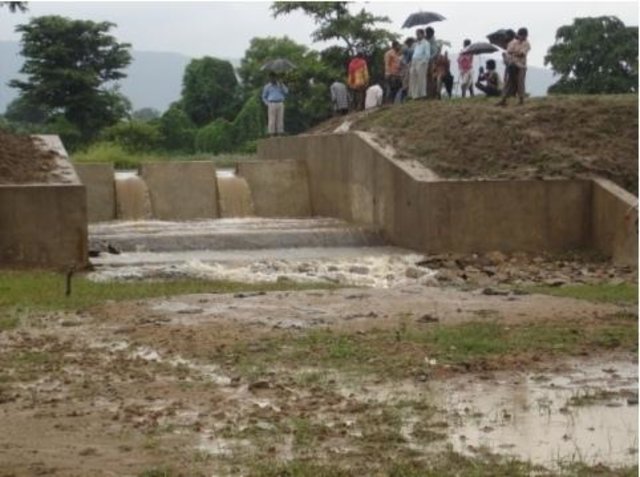
Diversion Weir [印度]
Diversion weir is a masonary check dam constructed across a perinnial or semi perinnial stream to divert the runoff water into land users field for irrigation.
- 编制者: Niranjan Sahu
2. SLM方法的描述
2.1 该方法的简要说明
Group is formed based on a common interest such as irrigation to their fileds from the diversion weir.
2.2 该方法的详细说明
该方法的详细说明:
Aims / objectives: 1. To creat village level organisation so that post project maintenance is ensured. 2. To encourage community participation in the programme. 3. To ensure equi-distribution of benefits.
Methods: Common Interest group implements the programme, mobilising resources from the watershed committee.
Stages of implementation: 1. Site selection. 2. Layout. 3. Foundation. 4. Construction of Superstructure. 5. Earthen embankment and guidebunds construction. 6. Turfing. 7. Construction of irrigation channel. 8. User's contribution during the process of implementation.
2.3 该方法的照片
2.5 采用该方法的国家/地区/地点
国家:
印度
区域/州/省:
Orissa
Map
×2.6 该方法的开始和终止日期
注明开始年份:
2005
终止年份(若不再采用该方法):
2010
2.7 方法的类型
- 基于项目/方案
2.8 该方法的主要目的/目标
The Approach focused mainly on SLM with other activities (Cropping system, Irrigation)
Oranise community into common interest group; build their capacity, provide financial support and guide them to implement their own programme in a participatory manner so that the post project sustainability is ensured and the benefits from the project reaches to the right people with right propertion.
The SLM Approach addressed the following problems: natural calamity(drought); Poverty;Illiteracy; Sustainability in agriculture production, Poor socio economic conditio of the people
2.9 推动或妨碍实施本办法所适用的技术的条件
社会/文化/宗教规范和价值观
- 阻碍
Do not unite to solve a problem
Treatment through the SLM Approach: Organised into groups, identified their common problem and came out the possible solution
财务资源和服务的可用性/可得性
- 阻碍
People are not able to afford the cost
Treatment through the SLM Approach: WORLP provided financial support for construction of the structure
法律框架(土地使用权、土地和水使用权)
- 阻碍
The existing land ownership, land use rights / water rights hindered a little the approach implementation Due to low land holding, the number of land users are high; thus the community mobilisation is less effective.
了解SLM,获得技术支持
- 阻碍
lack technical knowledge
Treatment through the SLM Approach: SWC specialist assisted in planning, designing and implementation of the structure
3. 相关利益相关者的参与和角色
3.1 该方法涉及的利益相关者及其职责
- 当地土地使用者/当地社区
Working land users were mainly men
Men are worried about the land degradation and irigation where as women are concerned with the types of crops. 45 marginal and small farmers are benefiting from the structure. They were formed into a group and all the group members were involved during the decision making process like selection of site, layout of the channel etc.
- SLM专家/农业顾问
- 国家政府(规划者、决策者)
如果涉及多个利益相关者,请注明领导机构:
The concept of common interest group was developed by social scientists.
3.2 当地土地使用者/当地社区参与该方法的不同阶段
| 当地土地使用者/当地社区的参与 | 指定参与人员并描述活动 | |
|---|---|---|
| 启动/动机 | 互动 | Mainly:rapid/participatory rural appraisal; partly: public meetings; Situational analysis was done using participatory tools like Social map ,Resource map and Transect. |
| 计划 | 互动 | rapid/participatory rural appraisal |
| 实施 | 外部支持 | Mainly: responsibility for major steps; partly: casual labour; Community contribution, Quality control, arraning of materials and labours were the major tasks performed by the land users. |
| 监测/评估 | 自我动员 | Mainly: measurements/observations; partly: public meetings; They were taking measurements as per the estimate while the construction was going on. They were also ensuring proper mix of materials while preparing mixtures of sand, cement, chips. |
| Research | 无 |
3.4 有关SLM技术选择的决策
具体说明谁有权决定选择要实施的技术:
- 主要是土地使用者,由SLM专家提供支持
解释:
The selection of site for the structure was decided by the and users along with the SWC speciality.The positive and negative impact of the structure was discussed while finalising the location.
Decisions on the method of implementing the SLM Technology were made by mainly by land users supported by SLM specialists. SWC specilist helped in making the plan and design of the structure. He also assisted while alyout was given in the field.
4. 技术支持、能力建设和知识管理
4.1 能力建设/培训
是否为土地使用者/其他利益相关者提供培训?:
是
明确受训人员:
- 土地使用者
- SWC specialists
培训形式:
- 在职
- 农民对农民
- 示范区域
涵盖的主题:
Class room as well as on farm training provided to land users.
4.2 咨询服务
土地使用者有权使用咨询服务吗?:
是
指明是否提供了咨询服务:
- 在固定中心
说明/注释:
Name of method used for advisory service: Participatory extension methods and exposure to successful sites, demo plots.; Key elements: Learning by Seeing, Learning by doing; 1) Advisory service was carried out through: projects own extension structure and agents 2) Advisory service was carried out through: projects own extension structure and agents; Extension staff: specifically hired project employees 3) Target groups for extension: land users
Advisory service is inadequate to ensure the continuation of land conservation activities; The staff strength in govt is very less, that is why project has hired experts from open markets and also developed community link workers for extension.
4.3 机构强化(组织发展)
是否通过这种方法建立或加强了机构?:
- 是,适度
具体说明机构的强化或建立程度:
- 本地
具体说明支持类型:
- 能力建设/培训
4.4 监测和评估
监测和评估是该方法的一部分吗?:
是
注释:
bio-physical aspects were regular monitored through measurements
technical aspects were ad hoc monitored through measurements
socio-cultural aspects were ad hoc monitored through observations
economic / production aspects were ad hoc monitored through observations
area treated aspects were regular monitored through observations
management of Approach aspects were ad hoc monitored through observations
There were few changes in the Approach as a result of monitoring and evaluation: Guidebank constructed to increase temporary storage in the structure. Increased participation and ownership. The CIG strengthened. Views of the land users respected and involved in decision making.
4.5 研究
研究是该方法的一部分吗?
是
明确话题:
- 社会学
- 技术
提供进一步的细节,并指出是谁做的研究:
Technology is looked with gender lens. Participatory technology development is an inbuilt strategy in the WORLP project.
Research was carried out on-farm
5. 融资和外部物质支持
5.1 该方法中SLM组成部分的年度预算
如果不知道准确的年度预算,请给出一个范围:
- 10,000-100,000
注释(例如主要的资助来源/主要捐助者):
Approach costs were met by the following donors: local community / land user(s) (CIG members (50); Watershed Committee/other members (20)): 70.0%; other (Project Support): 30.0%
5.2 为土地使用者提供财政/物质支援
土地使用者是否获得实施该技术的财政/物质支持?:
否
5.3 对特定投入的补贴(包括劳动力)
- 无
如果土地使用者的劳动力是一项重要的投入,那么是不是:
- 自愿
注释:
They contributing their labour for PRA, Planning, meeting etc.
5.4 信用
是否根据SLM活动的方法给予信用值?:
否
6. 影响分析和结论性陈述
6.1 方法的影响
该方法是否帮助土地使用者实施和维护SLM技术?:
- 否
- 是,很少
- 是,中等
- 是,支持力度很大
Got water to their field since the water was diverted. 45-60 acres of land production and productivity increased.
该方法是否改善了阻碍SLM技术实施的土地使用权/用户权问题?:
- 否
- 是,很少
- 是,中等
- 是,支持力度很大
Decision making is difficult.
Did other land users / projects adopt the Approach?
- 否
- 是,很少
- 是,中等
- 是,支持力度很大
Other Watershed programme in the state has slowly adopting this approach
6.3 方法活动的可持续性
土地使用者能否维持通过该方法实施的措施(无外部支持的情况下)?:
- 是
若是,请说明如何维持:
They are now empowerd to take their own decisions. They are acting as pressure group and leveraging resources from other line departments.
6.4 该方法的长处/优点
| 土地使用者眼中的长处/优势/机会 |
|---|
| 'We will manage the Diversion weir, cultivate paddy, ground nut, Onion and Brinjal.' (How to sustain/ enhance this strength: We will maintain this structure from our own contribution.) |
| 编制者或其他关键资源人员认为的长处/优势/机会 |
|---|
| Community Based Organisation are the local institutions which can manage their own. (How to sustain/ enhance this strength: Limited support as and when required) |
| Self monitoring by the land users |
| Ownership (How to sustain/ enhance this strength: User rights ensured, common fund developed) |
6.5 该方法的弱点/缺点以及克服它们的方法
| 土地使用者认为的弱点/缺点/风险 | 如何克服它们? |
|---|---|
| Since, SWC is a big investment. If, for some natural calamaity, the structure collapse it will be very difficult to reconstruct. |
| 编制者或其他关键资源人员认为的弱点/缺点/风险 | 如何克服它们? |
|---|---|
| Sometime over ambitious since social change is very slow | Expectation should not be raised while mobilising the community |
7. 参考和链接
7.1 方法/信息来源
- 实地考察、实地调查
- 与土地使用者的访谈
链接和模块
全部展开 全部收起链接

Diversion Weir [印度]
Diversion weir is a masonary check dam constructed across a perinnial or semi perinnial stream to divert the runoff water into land users field for irrigation.
- 编制者: Niranjan Sahu
模块
无模块


